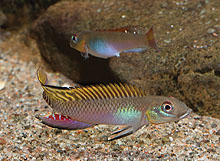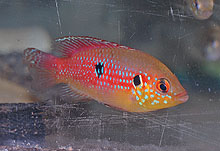WHAT'S NEW ACROSS THE WORLD
Select date in side bar to go to a What's New of previous issues
| What's New
©by Laif DeMason
Winter has seemingly come early across most of the United States this year. Not such a bad thing for most aquarium fish keepers as we can spend more time inside with our fish. Many hobbyists now seem to buy wild cichlids from private importers who work from their homes. This is especially true for Tanganyika cichlids. Since most of these importers do not treat their imported fish, it is essential for buyers to quarantine these buys so disease does not spread to their other pets. The stress of capture, holding with no food, and shipping across the world weakens these wild imports making them susceptible to disease. Further, many of these export facilities end up developing particularly virulent strains of bacteria due to short course treatments and weak (cheap) antibiotics purchased locally. If these drug resistant diseases are let loose in your fish rooms, Katie bar the door!
Here’s “what’s new” on the cichlid scene: |
Lake Tanganyika
Recent new collections in northern Congo have stimulated the Tanganyika fan base, bringing forth some rarely seen items.
| WHAT'S NEW: LAKE TANGANYIKA |

Cyprichromis microlepidotus has been harvested from various locations such as Pemba, Kiriza, Mboko, and Karamba. Many of these locations have two or more morphs occurring in the same population. Pictured here a form of C. microlepidotus at Pemba (Bemba), Congo. Photo by A. Konings.
|

Recently collected from Pemba (Bemba), Congo, Julidochromis marlieri. This fish looks similar to the Burundi J. marlieri with the rich black markings against a cream white background. Another species looking more like J. regani also arrived mixed with these fishes. Photo by A. Konings.
|

Not seen in any import shipments for several years, Tropheus brichardi from Karilani Island, Tanzania has arrived again. Interestingly, this fish sports bright yellow ventral fins which implies fry will have the same. Note also the whitish-cream head coloration not known in T. brichardi from other locations.
|

An absolutely amazing Tropheus variety is the Tropheus Karamba or red head from the Ubwari Peninsula, Congo. A Tropheus sp. ‘black’ form with bright red anterior markings always impresses. Juveniles of this fish were available for decades but were never as popular as the Tropheus Bemba at a small size.
|
Lake Malawi
Still popular among wild imports are predatory or colorful haplochromines along with mbuna with OB females.

Found incidentally at many locations lake wide, Mylochromis labidodon has arrived in small numbers. If you’re interested in this kind of fish, buy it when it is available as usually it cannot be caught on demand. Photo by A. Konings.
|

An example of a colorful ‘hap’ that interests wild Malawi hobbyists is Mylochromis sp. ‘lateristriga makanjila’ from Chimate, Tanzania. The shape of this predator hap with its pointed nose and later full colors sells this item to wild Malawi fans.
|

A real dwarf West African species is Congochromis sabinae, hailing from creeks near Nioki, Congo. Wild adults are about 1.25” (3 cm) maximum with a red throat area and are easily kept; ideal in planted tanks. Photo by O. Lucanus.
|

Another dwarf species although not as small is Nanochromis splendens. This fish is sourced northwest of Kinshasa at infrequently harvested areas at a remote location in the Congo River. Courting pairs have exceptional colors! Photo by O. Lucanus.
|

A new form of jewelfish first exported a few years ago is the Hemichromis sp. ‘Moanda’. This fish sports a bright yellow ventral area along with a strikingly red dorsum. Also this fish doesn’t seem to be as aggressive as other species of jewelfish.
|

An additional wild item from Moanda, Congo, Pelvicachromis subocellatus is one of the most uniquely colored cichlids. Breeding females display a bright pink and chrome midsection and turn completely black at each end, both head and tail. Photo by O. Lucanus.
|
Select date in side bar to go a What's New of previous issues |









